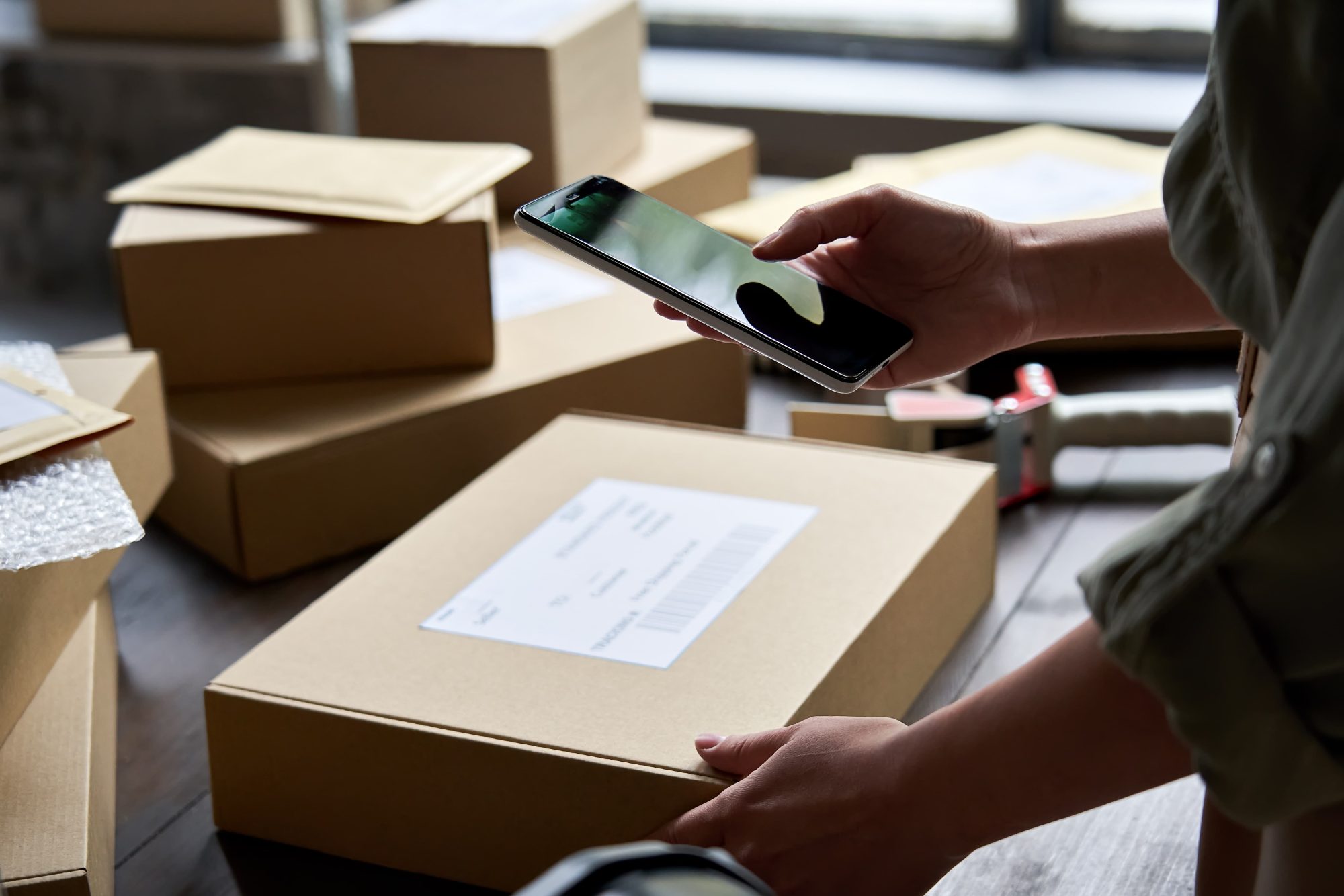From Doorstep Theft to Fake Returns: How to Fight Back Against Smartphone Ecommerce Fraud

We are moving into the time of year when the major manufacturers release their newest flagship phones, and retailers and carriers will be busy shipping more devices directly to consumers. Home deliveries are, unfortunately, an opportune moment for organized thefts, capitalizing on the surge in online orders.
Theft of Trade In and Return Devices
It’s not only new phones at risk, even older phones being shipped back (for trade in or warranty returns) are getting stolen. Many mobile customers now mail in their used handsets to carriers or buy back programs when upgrading. Unfortunately, criminals or unscrupulous employees have figured out how to identify these in-transit return packages. Fraudulent retail returns have become “a growing and troubling trend in e-commerce,” according to The Wall Street Journal, which reports that criminal gangs are exploiting retailers’ returns processes to steal goods and money.
There have been numerous reports on forums of trade-in phones “vanishing” in transit, only for the box to arrive empty or with random objects inside. There are two types of Empty Box scams. One is when a customer claims not to have received their package when, in actual fact, they have.
Then, there’s the scam where consumers return either an empty box, a device of lesser value or even something completely random. In these cases, the shipping label itself can tip off thieves, packages sent to known return center addresses practically advertise that a valuable device is inside.
One investigation found that Samsung even stopped using FedEx Ground for returns after noticing that longer shipping routes (with more handling points) led to more of these theft incidents. The problem has affected all major brands’ trade in programs: if a package is intercepted and the phone removed, the customer might be left fighting to prove they didn’t send an empty box.
These return-package thefts highlight a lesser-known aspect of supply chain vulnerability. The reverse logistics of sending phones back is just as susceptible to theft as forward shipments if not more so, since thieves know exactly where those boxes are headed and what’s likely inside. Consumers are now advised to take precautions like recording an unboxing/packing video and using tamper-evident tape when mailing back devices, or to return phones in person at a store whenever possible.
The reverse logistics supply chain can be and needs to be secured as well as the traditional. Resellers in the growing second-hand mobile device market adopt a definitive smartphone locking technology, something our CEO Dion Price debated with Ben Wood, Chief Analyst at CCS Insight in this video – Why should resellers in the growing second-hand mobile device market adopt a definitive smartphone locking technology?
The Growing Issue of Porch Pirates
Phones are one of the hottest items for ‘porch pirates’, especially the latest flagship models. By obtaining information from intercepting the tracking numbers, they know exactly what is expected to be delivered and when, leading to an increasingly sophisticated range of tactics to intercept the expensive deliveries.
In late 2024, law enforcement in the U.S. warned of a nationwide crime spree targeting FedEx deliveries of new iPhones. Gangs are obtaining package tracking and delivery info (sometimes by leaking or hacking carrier systems) so they know precisely when and where high-value phones will be dropped off. Armed with this intel, thieves will shadow delivery trucks and strike within moments of a package being left at the door. Multiple doorbell camera videos across different states captured the scheme: a FedEx driver leaves an AT&T phone package on the doorstep, and seconds later a thief in a faux delivery vest sprints in to snatch it.
Often, the thief is disguised as a courier (wearing Amazon or construction vests and carrying fake delivery bags) to avoid suspicion. This has become an alarming trend. In one example, a family in Texas ordered five new iPhones only to have all five stolen within seconds of delivery, as caught on their security camera.
Why are certain customers being hit so hard? One reason is a lack of required signatures. Carriers like AT&T traditionally did not require a signature for phone deliveries, making it easy to simply grab the box and run.
By contrast, Verizon and T-Mobile do require signatures for device deliveries. Thieves know this and have exploited it – police even found some suspects carrying lists of AT&T tracking numbers so they could target specific packages at the right moment.
This rash of doorstep phone thefts illustrates how increased direct-to-consumer shipping has led to new vulnerabilities. The convenience of home delivery can turn into a nightmare for consumers and a windfall for organized thieves, if security measures (like signature verification or real-time tracking alerts) aren’t in place.
Consumers are taking the initiative with preventative technology; doorbell cameras, tracking technology and lock boxes, or ultimately having to decide to disrupt their day and wait at home for it to arrive safely. Police are also actively trying to reduce the problem, even planting airtags in decoy packages to catch thieves in action.
The Hidden Threats Costing Retailers Millions
These losses are costing businesses and consumers millions, the total value of parcels stolen across the UK rose to £376m in the past year – up from £204m in 2023.
Under consumer rights legislation, retailers are liable if an order goes astray, so they typically pick up the tab when goods are stolen. The British Retail Consortium said theft, including porch piracy, costs retailers more than £2.2 billion a year. US retailers, meanwhile, are charging a few extra dollars on orders as package protection to protect against lost and stolen orders.
Bulk Heists and Insider Theft in the Supply Chain
Beyond porch piracy and isolated package thefts, criminals also continue to target bulk shipments and inventory on a larger scale. Warehouses, distribution centers, and trucks carrying loads of new devices can be extremely lucrative targets. The U.S. recently saw a single truckload of 54,000 phones stolen in transit in Florida, with losses over $11 million – illustrating how one successful hit on a container or trailer can dwarf dozens of porch thefts.
Insider involvement is a common thread in many of these cases. Large thefts often suggest that thieves had inside information about the shipment’s contents or timing. Sometimes, employees of logistics providers themselves are the culprits. For example, in April 2025, two FedEx warehouse workers in Pennsylvania were charged with running a theft ring that siphoned off over 180 smartphones (worth ~$173,000) from shipments over a few months.
They recruited accomplices to resell the stolen phones via electronic kiosks (ecoATMs) for quick cash, but investigators eventually tracked the devices back to the FedEx facility and caught the perpetrators. Similarly, in Florida, police busted a UPS delivery hub scheme where employees systematically stole high-end electronics (including phones) worth hundreds of thousands of dollars before they ever reached stores. These insider-enabled thefts underscore the importance of tight security and vetting within the supply chain; a single rogue employee can bypass many external protections.
Confronting the Problem
The rise in mobile phone supply chain theft has not gone unnoticed by industry and authorities. Carriers and retailers are taking steps to harden their logistics. Some, like Verizon and T-Mobile, require delivery signatures for high-value devices to deter doorstep snatchers. AT&T, after seeing the fallout of its no-signature policy, has been working with law enforcement and shippers on protective measures and quicker fraud detection.
Shipping companies are also bolstering security for instance, using more discrete packaging, enhancing parcel tracking, and monitoring for suspicious reroute requests. Law enforcement agencies have formed cargo theft task forces, and recent busts (like the 13-member ring in New Jersey) show a willingness to go after the larger networks. There is also an increasing focus on technological defenses. The NICB recommends rigorous verification of carriers and use of GPS trackers (well-hidden ones) on high-value loads.
The rigorous Trustonic device locking platform allows companies to lock devices at the software level until they are properly activated by the rightful end customer. This means a stolen phone would be rendered useless to thieves.
Experts and even government officials are calling for stronger, more universal action. In the UK, for example, police and MPs have urged Apple and Google to implement kill switches that would block stolen phones from accessing app and cloud services, making them far less valuable to steal.
Supply chain theft of mobile phones is a serious and growing problem as the volume of devices shipped has increased. Organized theft rings – employing both high-tech deceit and old-fashioned smash-and-grab tactics – are exploiting every link in the chain, from warehouses and trucks to home porches and return boxes. The data shows an uptick in these crimes globally, with costly losses impacting manufacturers, carriers, retailers, and consumers alike.
However, with greater awareness, collaborative security efforts, and new anti-theft technologies, the industry is starting to fight back. Reducing the ease with which stolen phones can be resold (for example, through stricter activation controls and international cooperation on device blacklists) will be key to stem the tide.
For now, though, the trend is clear: as more phones ship, more thieves are trying to intercept them – making supply chain security an essential focus for the mobile phone ecosystem moving forward.
